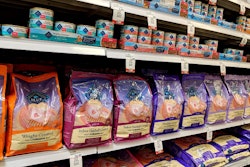
Two main reasons cause pet food companies’ online presences to fail at generating sales, said Diana Mercado, founder of Zoo Inc., during her presentation at the Pet Food Industry Congress in Latin America (CIPAL) in Buenos Aires, Argentina on September 18, 2019.
Mercado also presented her own observations on how well Argentinian and other pet food brands made use of online resources. For example, she noted that selling directly to consumers gives pet food brands an immediate channel of communication and commerce with pet owners, but Mercado found that relatively few pet food companies both in Argentina and globally use this sales method. Even when they don’t sell directly, pet food brands can still maximize the selling potential of their websites, yet she said many brands leave low-hanging fruit unplucked, such as not providing a map to find retail sales locations.
First reason websites fails to generate pet food sales
People aren’t just going to come to a website because it exists, Mercado said. They have to be told a pet food brand not only has a website, but be made aware that they can buy the products directly online. If a brand fails to get that message across, then it falls victim to the main reason she has seen online sales flounder. Making pet owners aware of a brand’s online presence involves a network of interrelated channels and media.
“From the web, out to intermediaries to social media, and even to offline, the call to action is always to your website,” Mercado said.
Offline promotions can involve special events, store signage, sales representatives and vehicle fleets. In the digital space, numerous online pet food retailers now operate in Argentina, including Puppis, Timberline and Mercado Libre. Social media, such as Twitter and Instagram also need to drive pet owners to a pet food company’s website.
Once pet owners have arrived at a brands’ website, they need to find good content, Mercado said. The three keys to that are making information that is segmented to focus on certain demographic groups, relevant to pet food buyers and scalable. For example, Purina provides news and information about pets on their website, along with detailed profiles of ingredients.
Second reason websites fail to generate pet food sales
Once the first hurdle has been overcome and pet owners are visiting a brand’s website, the online presence can still fail if there is no conversion from visits to sales. To boost those conversions, Mercado recommends that a pet food brand’s website be comfortable, trusty and rapid. For example, the first few moments are crucial and this is where speed takes precedence.
Every half second that it takes to load a website, reduces sales conversion by 20%, she said. Once that website loads, it needs to have and easy to use design that pet owners feel comfortable navigating. Along with that goes avoiding pop-ups, cookie messages and invasive chat windows. While these techniques may collect valuable information, they can also drive away yet-more-valuable sales or consumer attention. Along with that, consumers don’t always trust companies’ motives for collecting information and monitoring people’s activities.
On the other hand, building trust comes from providing abundant information about a product and maintaining transparent communications. For example, pet food brands selling directly to owners should present pricing clearly. Images should show the actual kibble, treat or other product, not just the bag or stock images of a happy pet parent. When describing a pet food or treat online, Mercado recommends focusing on the benefits associated with a particular pet food and its ingredients, not its characteristics.
In Argentina and around the world, online sales of pet food continue to increase, Mercado said. Brands can take advantage of this trend if they avoid the two main reasons that pet food brands’ websites fail to generate sales.

















